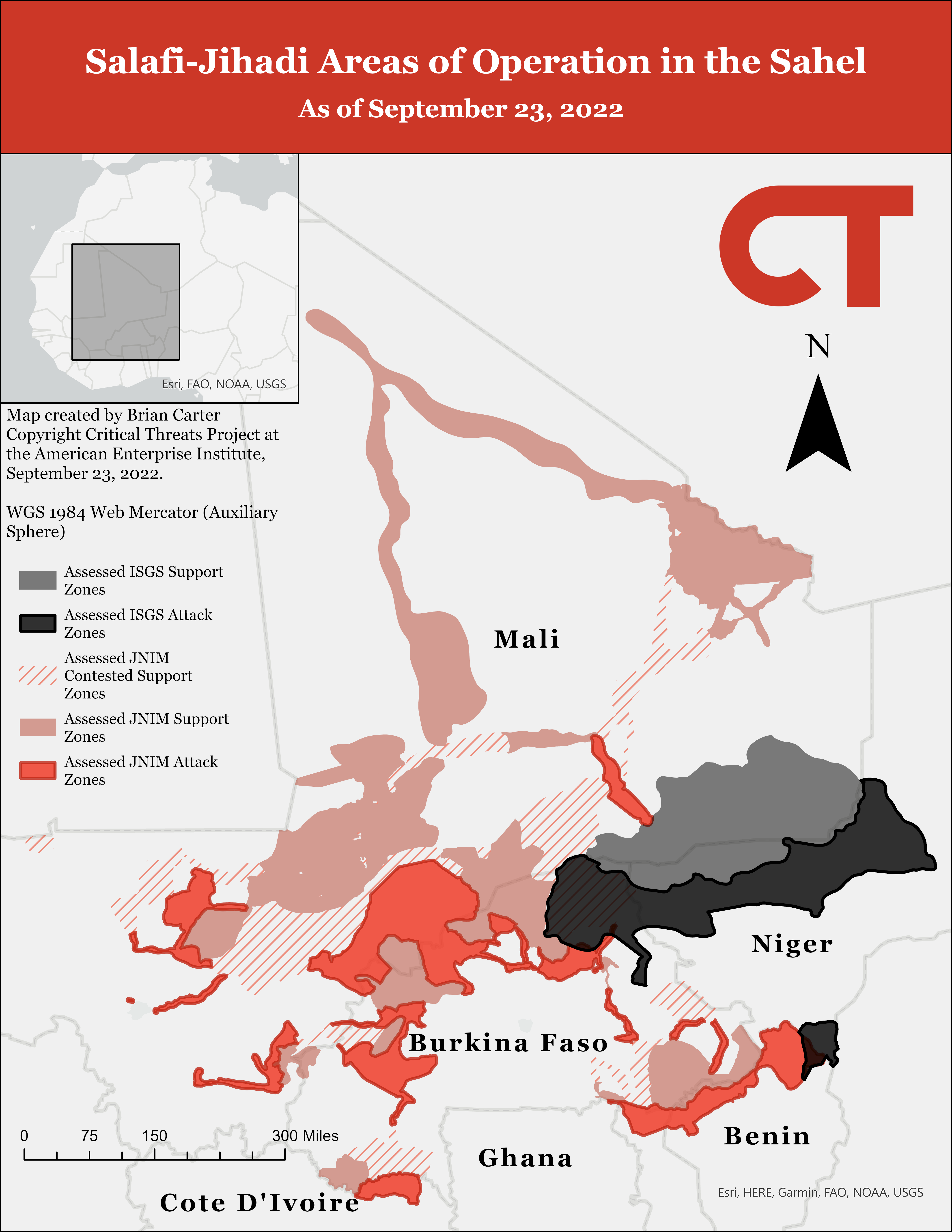{{currentView.title}}
September 30, 2022
Salafi-Jihadi Areas of Operation in the Sahel
Al Qaeda and Islamic State affiliates are expanding rapidly in West Africa’s Sahel region, taking advantage of long-running grievances and state incapacity. The predominant groups are Jama’at Nusrat al Islam wa al Muslimeen (JNIM), which is an affiliate of al Qaeda in the Islamic Maghreb (AQIM), and the Islamic State’s Sahel Province, also known as Islamic State’s Greater Sahara Province (ISGS). Salafi-jihadi activity first spiked in the Sahel when AQIM and local partners co-opted a rebellion in northern Mali and attempted to establish an emirate. A French-led intervention rolled back this initial takeover, but Salafi-jihadi groups have continued to proliferate and expand in the past decade, particularly throughout central Mali and Burkina Faso. JNIM and ISGS have also begun to operate in the border regions of the Gulf of Guinea states in recent years.
Map updated September 23, 2022
Attack Zone: An area where units conduct offensive maneuvers.
Contested Support Zone: An area where multiple groups conduct offensive and defensive maneuvers. A group may be able to conduct effective logistics and administrative support of forces but has inconsistent access to local populations and key terrain.
Support Zone: An area where a group is not subject to significant enemy action and can conduct effective logistics and administrative support of forces.
Control Zone: An area where a group exerts largely uncontested physical or psychological pressure to ensure that individuals or groups respond as directed. Control zones are a subset of support zones.
Methodology Note: The Critical Threats Project adapts its mapping definitions for insurgencies from US military doctrine, including US Army FM 7-100.1 Opposing Force Operations. Our maps are assessments and reflect analysts’ judgment based on current and historical open-source information on security incidents, political and governance activity, and population and geographic factors. Please contact us for more information on specific maps.
Figure 1. Salafi-Jihadi Areas of Operation in the Sahel

Note: ISGS is Islamic State’s Sahel Province, also known as Islamic State’s Greater Sahara Province. JNIM is Jama’at Nusrat al Islam wa al Muslimeen.
Background: The Salafi-Jihadi Movement in the Sahel
The Salafi-jihadi movement in the Sahel has roots in the Algerian Salafi-jihadi movement of the early 2000s, from which AQIM emerged. AQIM gained influence in the Sahel throughout the 2000s, eventually infiltrating and co-opting a 2012 rebellion driven by long-running ethnic grievances in partnership with the northern Mali–based Ansar al Din. A French-led response rolled back AQIM and its allies’ conquest of northern Mali in 2013.
Four Salafi-jihadi groups merged to create JNIM in 2017: AQIM’s Sahara Emirate, Ansar al Din, the Macina Liberation Front, and al Murabitoun. A fifth group, based in Burkina Faso, Ansar al Islam, cooperates with but is not formally part of JNIM. JNIM is most active in Mali and Burkina Faso, though it is present in Niger and expanding into the northern Gulf of Guinea states. JNIM’s major subgroups—commonly referred to as katibat (brigades)—have embedded themselves into local governance structures.
ISGS formed when a faction of an AQIM splinter group pledged allegiance to the Islamic State in 2015. The Islamic State did not recognize ISGS as a formal province until March 2022. ISGS is most active in the tri-border region between Burkina Faso, Mali, and Niger. ISGS and JNIM, unlike other al Qaeda and Islamic State affiliates globally, did not initially fight each other. ISGS and JNIM clashes began in 2020 and resulted in JNIM substantially weakening ISGS. ISGS and JNIM agreed to a truce in May 2022 that ended regular clashes between the two groups.
ISGS and JNIM are gradually expanding south, toward the coastal Gulf of Guinea states. Overlapping issues—including climate change, poor governance, and communal tensions—are allowing the Salafi-Jihadi movement to embed in local communities. Since beginning their expansion deeper into the Sahel in 2016, both groups have caused massive population displacement and now control territory in Burkina Faso, Mali, and Niger. The capabilities and reach of both groups are increasing, in part due to disarray in regional counterterrorism efforts caused by the Malian military junta’s alienation of regional partners and the withdrawal of French forces from Mali in 2022.
